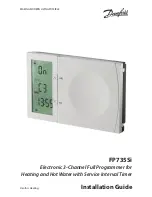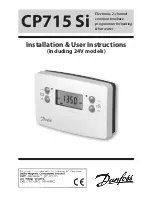
99.828.02 1.3/01/20
7/20
English
99.828.02 1.3/01/20
6/20
English
LDx 1x00-5 /-ACB
LDx 1x00-5 /-ACB
Technical Data
* Programmable with software SCS (only ACB) ** Running direction programmable with SCS (only ACB)
Closing edge protection
In the "CLOSE" direction the drive has an active
protection for the main closing edge. If there is an
overload in the closing ranges C3 and C2, the drive
runs "OPEN" for 10 seconds, then "CLOSE" again. If
closing is not possible after three attempts, the drive
remains in this position.
In addition, the drive is equipped with passive
protection. The closing speed in closing range C2
and C1 is reduced to 1 mm/s.
Significantly greater forces can be
exerted at the secondary closing edges.
Danger of crushing hands and fingers!
Starting
A reference run must be carried out for the first
starting and after exchange of one of the drives. In
this process the drive will determine its zero point
(Closed-position). This single event is called null
balance.
- Connect drive
- Trigger drive in CLOSED-direction
(independent on the position of louvres)
After an overload cutoff has been effected in
running direction „CLOSED", the drive will have a
new zero point. During the reference run, no
obstacle must impair the running of the louvres.
The hand guard in arms's reach is
deactivated during the reference
run (danger of squeezing)!
Electrical devices, accessories, batteries and packa-
ging should be sorted for environmental-friendly
recycling. Do not dispose electrical devices and
batteries into household waste!
Only for EC countries:
According the European Guideline 2012/19/EU for
waste electrical and electronic equipment and its
implementation into national right, electrcal devices
that are no longer usable must be collected separa-
tely and disposed of in an environmentally correct
manner.
Disposal
Wiring:
Is the drive or drive group wired properly?
See connection plans.
Diagnostics with SCS software (only ACB):
The SCS software and a BSY+ interface (BI-BT 2
or BI-USB) is required for further troubleshooting or
configuration.
Troubleshooting
Maintenance and cleaning
Maintenance work is only allowed when the device is in
a de-energized condition! Inspection and maintenance
has to be carried out according to D+H maintenance
notes. Only original D+H spare parts may be used.
Repair is to be carried out exclusively by D+H.
Wipe away debris or contamination with a dry, soft
cloth. Do not use cleaning agents or solvents.
Type
LDx-1400-5
LDx-1400-5-ACB
LDx-1800-5
LDx-1800-5-ACB
Power supply
230 V AC, +10 % / -15 %, 50 Hz
Nominal force
Input power
1400 N
42 W / 65 VA
1800 N
52 W / 75 VA
Stroke length
max. 90 mm
±
2 % *
Nominal locking force
Service life
Duty cycle
Housing
Ingress protection
Temp. range
Fire stability
Ambient humidity
Emission sound pressure level
Additional functions*
approx. 5000 N (Depending on the fastening)
>20.000 double strokes
30 %, With cycle time 10 minutes
Aluminium, silver anodised EV1
IP 40 (IP 44 with inserted gaskets)
-5 ... +75 °C
B300 (30 min / 300 °C)
≤ 90 %, not condensing
LpA ≤ 45 dB(A)
Closing edge protection = activated (3 repetitions of stroke)
Locking relief = activated
Opening and Closing Ranges LDx-1400 (LDx-1800)*
CLOSED**
OPEN**
Stroke limiting with magnets (not ACB)
Close drive.
1
3
learning mode
appr. 2 sec.
2
Voltage must continue to
be applied to the drive when
moving in the “CLOSE”
direction.
Hold the magnet next
to the drive as shown in the
diagramme (2 sec.) until you hear
a pulsating ton >
The
drive
is
now
in
learning
mode
.
The
magnet
can
now
be
removed
and
the
drive
no
longer
has
to
be
under
voltage
.
Allow the drive to run
“OPEN” until you reach the
required stroke.
If the stroke is set incorrectly,
the procedure is accidentally
interrupted or the drive
continues to the full stroke
length, please return to point 1
and start again.
Special magnet
MAG 502
STOP
appr
.1
1 cm
LDx-5
O1*
3 mm
1400 N (1800 N)
2 mm/s
O2*
85 mm
1400 N (1800 N)
2 mm/s
O3*
2 mm
1400 N (1800 N)
1 mm/s
C3*
65 mm
800 N (1000 N)
2 mm/s
C2*
20 mm
400 N (500 N)
1 mm/s
C1*
5 mm
800 N (1000 N)
1 mm/s






































